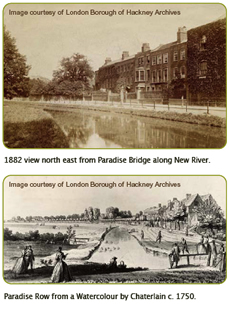Historic Interest
 |
The area is steeped in a rich and varied history, and at one time was a rural haven away from the bustle of city life. In 1755 one of the houses on Paradise Row was advertised as ‘new and well built’, paved with marble, with a large garden and by the mid-nineteenth century Paradise Row was one of the most desirable places to live in the whole of North London; the residence of bankers, brokers, merchants and manufacturers with gardens stretching to 100ft long.
During this period, and dating back to the 18th century, Paradise Row was the hub of a thriving Quaker Community concerned with philosophical and political issues, and was the birthplace of Samuel Hoare Jnr, one of the twelve founding members of the ‘Society for the Abolition of the Slave Trade’, who was often visited by other campaigners such as William Wilberforce and James Stephen. Hoare’s banking firm later merged to become what is now Barclays Bank.
In 1709, just a stone’s throw away on the north side of Church Street lived an author called Daniel Defoe. In 1703, Robert Drury, the son of local landowner John Drury was shipwrecked off Madagascar and not rescued until 1717. It is thought that this was the inspiration behind Defoe’s novel ‘Robinson Crusoe’.
Despite now being firmly part of the city itself, Stoke Newington has maintained its village feel and charm, and with its abundance of independent cafes, bars, shops and restaurants and excellent transport links it’s not surprising that it has become a much sought after hot spot for house buyers.

